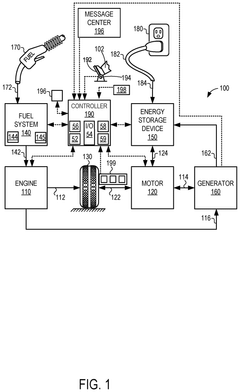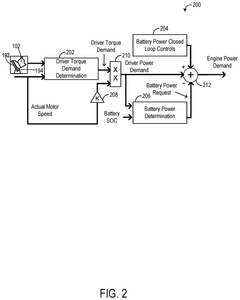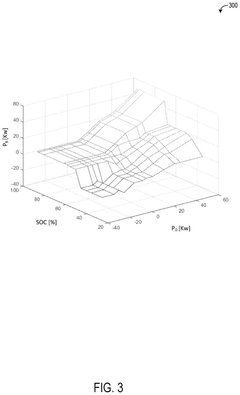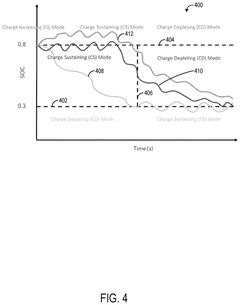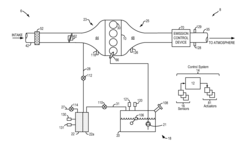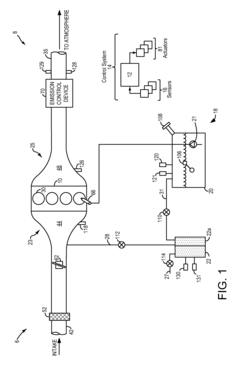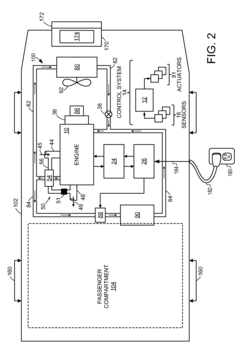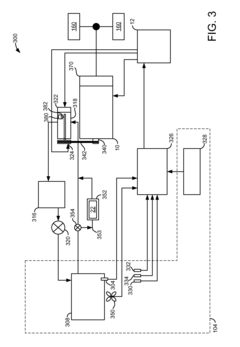PHEV's contribution to reducing industrial emissions
AUG 14, 20259 MIN READ
Generate Your Research Report Instantly with AI Agent
Patsnap Eureka helps you evaluate technical feasibility & market potential.
PHEV Emission Reduction Background and Objectives
Plug-in Hybrid Electric Vehicles (PHEVs) have emerged as a significant technological advancement in the automotive industry, offering a promising solution to reduce industrial emissions. The evolution of PHEV technology can be traced back to the early 2000s, with continuous improvements in battery capacity, electric motor efficiency, and overall system integration. As global concerns about climate change and air pollution intensify, PHEVs have gained traction as a viable transitional technology between conventional internal combustion engine vehicles and fully electric vehicles.
The primary objective of PHEV technology in the context of emission reduction is to significantly decrease greenhouse gas emissions and other pollutants associated with the transportation sector. By combining the benefits of electric propulsion with the extended range capabilities of internal combustion engines, PHEVs aim to provide a practical and efficient solution for reducing emissions without compromising on vehicle performance or user convenience.
The development of PHEV technology has been driven by several key factors, including stringent environmental regulations, advancements in battery technology, and increasing consumer demand for more fuel-efficient and environmentally friendly vehicles. Governments worldwide have implemented policies and incentives to promote the adoption of PHEVs, recognizing their potential to contribute to national and international emission reduction targets.
From a technical perspective, PHEVs incorporate sophisticated powertrain systems that seamlessly integrate electric motors with conventional engines. This integration allows for optimal energy management, enabling vehicles to operate in all-electric mode for short distances and switch to hybrid mode for longer journeys. The continuous improvement in battery technology, particularly in terms of energy density and charging efficiency, has been crucial in enhancing the electric-only range of PHEVs.
The contribution of PHEVs to reducing industrial emissions extends beyond the immediate impact on vehicle emissions. The technology has spurred innovation across the automotive supply chain, encouraging the development of more efficient components, lightweight materials, and advanced manufacturing processes. This ripple effect has led to broader improvements in energy efficiency and emission reduction across various industrial sectors.
Looking ahead, the trajectory of PHEV technology is expected to focus on further increasing electric range, improving overall system efficiency, and reducing production costs. These advancements aim to make PHEVs more accessible to a wider consumer base, thereby amplifying their impact on emission reduction. Additionally, ongoing research is exploring the integration of PHEVs with smart grid technologies, potentially enabling these vehicles to serve as distributed energy storage units and contribute to grid stability.
In conclusion, the background and objectives of PHEV emission reduction technology reflect a comprehensive approach to addressing environmental challenges while meeting consumer needs. As the technology continues to evolve, PHEVs are poised to play a crucial role in the transition towards a more sustainable transportation ecosystem, contributing significantly to the reduction of industrial emissions in the coming years.
The primary objective of PHEV technology in the context of emission reduction is to significantly decrease greenhouse gas emissions and other pollutants associated with the transportation sector. By combining the benefits of electric propulsion with the extended range capabilities of internal combustion engines, PHEVs aim to provide a practical and efficient solution for reducing emissions without compromising on vehicle performance or user convenience.
The development of PHEV technology has been driven by several key factors, including stringent environmental regulations, advancements in battery technology, and increasing consumer demand for more fuel-efficient and environmentally friendly vehicles. Governments worldwide have implemented policies and incentives to promote the adoption of PHEVs, recognizing their potential to contribute to national and international emission reduction targets.
From a technical perspective, PHEVs incorporate sophisticated powertrain systems that seamlessly integrate electric motors with conventional engines. This integration allows for optimal energy management, enabling vehicles to operate in all-electric mode for short distances and switch to hybrid mode for longer journeys. The continuous improvement in battery technology, particularly in terms of energy density and charging efficiency, has been crucial in enhancing the electric-only range of PHEVs.
The contribution of PHEVs to reducing industrial emissions extends beyond the immediate impact on vehicle emissions. The technology has spurred innovation across the automotive supply chain, encouraging the development of more efficient components, lightweight materials, and advanced manufacturing processes. This ripple effect has led to broader improvements in energy efficiency and emission reduction across various industrial sectors.
Looking ahead, the trajectory of PHEV technology is expected to focus on further increasing electric range, improving overall system efficiency, and reducing production costs. These advancements aim to make PHEVs more accessible to a wider consumer base, thereby amplifying their impact on emission reduction. Additionally, ongoing research is exploring the integration of PHEVs with smart grid technologies, potentially enabling these vehicles to serve as distributed energy storage units and contribute to grid stability.
In conclusion, the background and objectives of PHEV emission reduction technology reflect a comprehensive approach to addressing environmental challenges while meeting consumer needs. As the technology continues to evolve, PHEVs are poised to play a crucial role in the transition towards a more sustainable transportation ecosystem, contributing significantly to the reduction of industrial emissions in the coming years.
Market Demand for Low-Emission Vehicles
The market demand for low-emission vehicles has been steadily increasing in recent years, driven by growing environmental concerns, stricter emissions regulations, and changing consumer preferences. Plug-in Hybrid Electric Vehicles (PHEVs) have emerged as a significant player in this market, offering a bridge between conventional internal combustion engine vehicles and fully electric vehicles.
Consumer awareness of climate change and air pollution has led to a shift in purchasing behavior, with more buyers prioritizing eco-friendly transportation options. This trend is particularly evident in urban areas, where air quality concerns are more pronounced. As a result, PHEVs have gained traction as a practical solution that combines the benefits of electric driving for short trips with the flexibility of a gasoline engine for longer journeys.
Government policies and incentives have played a crucial role in stimulating demand for low-emission vehicles, including PHEVs. Many countries have implemented tax breaks, subsidies, and other financial incentives to encourage the adoption of cleaner vehicles. Additionally, stricter emissions standards and the introduction of low-emission zones in cities have further boosted the appeal of PHEVs.
The automotive industry has responded to this growing demand by expanding their PHEV offerings across various vehicle segments. From compact cars to SUVs and luxury vehicles, manufacturers are investing heavily in PHEV technology to meet consumer needs and comply with regulatory requirements. This diversification of PHEV models has broadened their appeal to a wider range of consumers.
Fleet operators and businesses are also contributing to the increased demand for PHEVs. Companies are increasingly adopting PHEVs as part of their corporate sustainability initiatives and to reduce their carbon footprint. The ability of PHEVs to operate in electric-only mode for short urban trips while maintaining the capability for longer journeys makes them an attractive option for fleet managers seeking to balance operational needs with environmental goals.
The market for PHEVs is expected to continue growing in the coming years, albeit at a varying pace across different regions. Developed markets such as Europe and parts of North America are seeing rapid adoption, while emerging markets are gradually catching up as infrastructure and awareness improve. However, the long-term growth of PHEVs may be influenced by advancements in battery technology and the increasing competitiveness of fully electric vehicles.
As the automotive industry transitions towards electrification, PHEVs serve as an important stepping stone, addressing range anxiety concerns and infrastructure limitations that still hinder widespread adoption of fully electric vehicles. Their ability to significantly reduce emissions in urban environments while providing the versatility of conventional vehicles positions PHEVs as a key component in the low-emission vehicle market for the foreseeable future.
Consumer awareness of climate change and air pollution has led to a shift in purchasing behavior, with more buyers prioritizing eco-friendly transportation options. This trend is particularly evident in urban areas, where air quality concerns are more pronounced. As a result, PHEVs have gained traction as a practical solution that combines the benefits of electric driving for short trips with the flexibility of a gasoline engine for longer journeys.
Government policies and incentives have played a crucial role in stimulating demand for low-emission vehicles, including PHEVs. Many countries have implemented tax breaks, subsidies, and other financial incentives to encourage the adoption of cleaner vehicles. Additionally, stricter emissions standards and the introduction of low-emission zones in cities have further boosted the appeal of PHEVs.
The automotive industry has responded to this growing demand by expanding their PHEV offerings across various vehicle segments. From compact cars to SUVs and luxury vehicles, manufacturers are investing heavily in PHEV technology to meet consumer needs and comply with regulatory requirements. This diversification of PHEV models has broadened their appeal to a wider range of consumers.
Fleet operators and businesses are also contributing to the increased demand for PHEVs. Companies are increasingly adopting PHEVs as part of their corporate sustainability initiatives and to reduce their carbon footprint. The ability of PHEVs to operate in electric-only mode for short urban trips while maintaining the capability for longer journeys makes them an attractive option for fleet managers seeking to balance operational needs with environmental goals.
The market for PHEVs is expected to continue growing in the coming years, albeit at a varying pace across different regions. Developed markets such as Europe and parts of North America are seeing rapid adoption, while emerging markets are gradually catching up as infrastructure and awareness improve. However, the long-term growth of PHEVs may be influenced by advancements in battery technology and the increasing competitiveness of fully electric vehicles.
As the automotive industry transitions towards electrification, PHEVs serve as an important stepping stone, addressing range anxiety concerns and infrastructure limitations that still hinder widespread adoption of fully electric vehicles. Their ability to significantly reduce emissions in urban environments while providing the versatility of conventional vehicles positions PHEVs as a key component in the low-emission vehicle market for the foreseeable future.
PHEV Technology Status and Challenges
Plug-in Hybrid Electric Vehicles (PHEVs) have emerged as a promising technology in the automotive industry's efforts to reduce industrial emissions. The current status of PHEV technology represents a significant advancement in combining conventional internal combustion engines with electric propulsion systems. However, several challenges remain in fully realizing their potential for emission reduction.
One of the primary technological advancements in PHEVs is the improvement in battery technology. Lithium-ion batteries have become the standard, offering higher energy density and longer life cycles compared to earlier nickel-metal hydride batteries. This has resulted in increased electric-only driving ranges, typically between 30 to 50 miles, which covers the daily commute of many users. However, battery cost and weight remain significant challenges, impacting vehicle affordability and overall efficiency.
Power management systems in PHEVs have also seen substantial improvements. Advanced control algorithms now optimize the use of electric and gasoline power, seamlessly switching between or combining both power sources for maximum efficiency. These systems have become more sophisticated, adapting to driving conditions and user habits to minimize emissions and fuel consumption. Nevertheless, further refinement is needed to maximize emission reduction across various driving scenarios.
The charging infrastructure for PHEVs has expanded significantly, with faster charging options becoming more widely available. However, the lack of a standardized charging system across different manufacturers and regions remains a challenge. This fragmentation can lead to consumer confusion and hesitation, potentially limiting PHEV adoption and, consequently, their impact on emission reduction.
Another technological challenge lies in the integration of regenerative braking systems. While these systems have improved in capturing and storing energy during deceleration, there is still room for enhancing their efficiency. More advanced regenerative braking could further extend electric driving range and reduce overall emissions.
The manufacturing process of PHEVs itself presents challenges in terms of emissions. The production of batteries and electric components can be energy-intensive and potentially polluting. Efforts are ongoing to make the manufacturing process more sustainable, but this remains an area requiring significant improvement to ensure that the overall lifecycle emissions of PHEVs are minimized.
Lastly, the software and connectivity aspects of PHEVs are rapidly evolving. Smart charging systems and vehicle-to-grid technologies show promise in optimizing charging times and potentially using PHEVs as part of a broader energy management system. However, cybersecurity concerns and the need for robust, user-friendly interfaces present ongoing challenges in fully leveraging these technologies for emission reduction.
One of the primary technological advancements in PHEVs is the improvement in battery technology. Lithium-ion batteries have become the standard, offering higher energy density and longer life cycles compared to earlier nickel-metal hydride batteries. This has resulted in increased electric-only driving ranges, typically between 30 to 50 miles, which covers the daily commute of many users. However, battery cost and weight remain significant challenges, impacting vehicle affordability and overall efficiency.
Power management systems in PHEVs have also seen substantial improvements. Advanced control algorithms now optimize the use of electric and gasoline power, seamlessly switching between or combining both power sources for maximum efficiency. These systems have become more sophisticated, adapting to driving conditions and user habits to minimize emissions and fuel consumption. Nevertheless, further refinement is needed to maximize emission reduction across various driving scenarios.
The charging infrastructure for PHEVs has expanded significantly, with faster charging options becoming more widely available. However, the lack of a standardized charging system across different manufacturers and regions remains a challenge. This fragmentation can lead to consumer confusion and hesitation, potentially limiting PHEV adoption and, consequently, their impact on emission reduction.
Another technological challenge lies in the integration of regenerative braking systems. While these systems have improved in capturing and storing energy during deceleration, there is still room for enhancing their efficiency. More advanced regenerative braking could further extend electric driving range and reduce overall emissions.
The manufacturing process of PHEVs itself presents challenges in terms of emissions. The production of batteries and electric components can be energy-intensive and potentially polluting. Efforts are ongoing to make the manufacturing process more sustainable, but this remains an area requiring significant improvement to ensure that the overall lifecycle emissions of PHEVs are minimized.
Lastly, the software and connectivity aspects of PHEVs are rapidly evolving. Smart charging systems and vehicle-to-grid technologies show promise in optimizing charging times and potentially using PHEVs as part of a broader energy management system. However, cybersecurity concerns and the need for robust, user-friendly interfaces present ongoing challenges in fully leveraging these technologies for emission reduction.
Current PHEV Emission Reduction Solutions
01 Emission control strategies for PHEVs
Various strategies are employed to control emissions in PHEVs, including optimizing the balance between electric and combustion engine operation, implementing advanced exhaust aftertreatment systems, and utilizing intelligent energy management systems to minimize overall emissions during different driving conditions.- Emission control strategies for PHEVs: Various strategies are employed to control emissions in PHEVs, including optimizing the balance between electric and combustion engine operation, implementing advanced exhaust aftertreatment systems, and utilizing intelligent energy management systems to minimize overall emissions during different driving conditions.
- Battery management for emission reduction: Effective battery management plays a crucial role in reducing emissions from PHEVs. This includes optimizing battery charging and discharging cycles, implementing smart charging strategies, and utilizing regenerative braking to maximize electric-only operation and minimize reliance on the internal combustion engine.
- Hybrid powertrain optimization: Optimizing the hybrid powertrain in PHEVs is essential for reducing emissions. This involves improving the efficiency of power distribution between the electric motor and internal combustion engine, implementing advanced control algorithms, and utilizing predictive energy management systems to minimize overall fuel consumption and emissions.
- Exhaust gas treatment technologies: Advanced exhaust gas treatment technologies are implemented in PHEVs to reduce harmful emissions. These may include catalytic converters, particulate filters, and selective catalytic reduction systems specifically designed to handle the unique emission characteristics of plug-in hybrid vehicles operating in various modes.
- Emission monitoring and diagnostics: PHEVs incorporate sophisticated emission monitoring and diagnostic systems to ensure optimal performance and compliance with emission standards. These systems may include real-time emission sensors, on-board diagnostics, and predictive maintenance algorithms to detect and address potential emission-related issues proactively.
02 Battery management for emission reduction
Effective battery management plays a crucial role in reducing emissions from PHEVs. This includes optimizing battery charging and discharging strategies, implementing advanced battery thermal management systems, and utilizing predictive algorithms to maximize electric-only driving range and minimize reliance on the internal combustion engine.Expand Specific Solutions03 Hybrid powertrain optimization
Optimizing the hybrid powertrain in PHEVs is essential for reducing emissions. This involves developing advanced control algorithms for seamless integration of electric and combustion power sources, implementing efficient power split strategies, and utilizing regenerative braking systems to maximize energy recovery and minimize overall emissions.Expand Specific Solutions04 Emissions monitoring and diagnostics
Advanced emissions monitoring and diagnostic systems are implemented in PHEVs to ensure optimal performance and compliance with environmental regulations. These systems include real-time emissions sensors, on-board diagnostic tools, and predictive maintenance algorithms to detect and address potential emission-related issues proactively.Expand Specific Solutions05 Integration of renewable energy sources
To further reduce emissions, PHEVs are being designed to integrate with renewable energy sources. This includes developing smart charging infrastructure that prioritizes renewable energy sources, implementing vehicle-to-grid (V2G) technologies, and optimizing charging strategies based on the availability of clean energy to minimize the overall carbon footprint of PHEV operation.Expand Specific Solutions
Key PHEV Manufacturers and Suppliers
The PHEV (Plug-in Hybrid Electric Vehicle) market is in a growth phase, with increasing adoption as automakers strive to meet stringent emissions regulations. The global PHEV market size is projected to expand significantly in the coming years, driven by environmental concerns and government incentives. Technologically, PHEVs are relatively mature, with major players like Ford Motor Co., BMW AG, and Volvo continuously improving their offerings. Ford Global Technologies LLC and Bayerische Motoren Werke AG are at the forefront of PHEV innovation, focusing on enhancing battery technology and powertrain efficiency. Emerging players such as Turntide Technologies, Inc. are also contributing to the sector's advancement, particularly in electric motor systems. The competitive landscape is intensifying as traditional automakers and new entrants vie for market share in this rapidly evolving segment.
Ford Motor Co.
Technical Solution: Ford has developed advanced PHEV technology to reduce industrial emissions. Their approach includes the use of a high-efficiency Atkinson-cycle engine combined with an electric motor and lithium-ion battery pack. This system allows for extended electric-only driving range, typically 30-40 miles, before switching to hybrid mode [1]. Ford's PHEVs also incorporate regenerative braking and intelligent energy management systems to maximize efficiency. The company has implemented a flexible manufacturing strategy, allowing them to produce PHEVs alongside conventional vehicles on the same production lines, reducing overall industrial emissions from manufacturing processes [2]. Additionally, Ford is investing in sustainable materials for PHEV components, such as soy-based foam for seats and recycled plastics for underbody shields, further reducing the carbon footprint of their vehicles [3].
Strengths: Established manufacturing infrastructure, advanced powertrain technology, and integration of sustainable materials. Weaknesses: Dependency on battery supply chains and potential challenges in scaling up PHEV production to meet increasing demand.
Volvo Lastvagnar AB
Technical Solution: Volvo Trucks has developed a unique approach to PHEV technology for heavy-duty vehicles to reduce industrial emissions. Their system, known as "I-SAM" (Integrated Starter Alternator Motor), combines a diesel engine with an electric motor and a lithium-ion battery pack [7]. This technology allows for zero-emission operation in urban areas and improved fuel efficiency on highways. Volvo's PHEV trucks can operate in fully electric mode for up to 35 km, making them suitable for urban distribution and construction work with minimal emissions [8]. The company has also implemented a regenerative braking system that recovers energy during deceleration, further improving overall efficiency. In addition to vehicle technology, Volvo has focused on optimizing charging infrastructure for their PHEV trucks, developing fast-charging solutions that can significantly reduce downtime [9]. The company is also exploring the use of renewable fuels in the combustion engine component of their PHEVs to further reduce overall emissions.
Strengths: Specialized PHEV technology for heavy-duty vehicles, focus on urban applications, and development of supporting infrastructure. Weaknesses: Limited electric-only range compared to passenger PHEVs and higher initial costs for fleet operators.
Core PHEV Emission Control Innovations
Systems and methods for drive mode control
PatentPendingUS20250222916A1
Innovation
- A method for controlling PHEV operation by receiving route data, determining electric range, and adjusting drive modes to suppress engine operation or prioritize low-carbon fuel use, including charge sustaining or increasing modes before refueling, and suggesting low-emission charging or refueling stops based on route conditions.
Systems and methods for managing bleed emissions in plug-in hybrid electric vehicles
PatentInactiveUS20150158377A1
Innovation
- A method and system that cool the fuel vapor canister using external power when the vehicle is plugged in and parked, employing temperature sensors and control systems to adjust cooling based on ambient temperature and canister load, thereby reducing bleed emissions without expending battery energy.
Environmental Policy Impact on PHEV Development
Environmental policies have played a crucial role in shaping the development and adoption of Plug-in Hybrid Electric Vehicles (PHEVs). These policies have been instrumental in driving innovation, promoting cleaner technologies, and reducing industrial emissions across the automotive sector.
Governments worldwide have implemented various regulatory measures to encourage the production and use of PHEVs. These include stringent emission standards, fuel economy regulations, and incentives for manufacturers to invest in low-emission technologies. Such policies have compelled automakers to prioritize the development of PHEVs as a means to comply with increasingly strict environmental regulations.
Financial incentives have been a key policy tool in promoting PHEV adoption. Many countries offer tax credits, rebates, and subsidies to consumers who purchase PHEVs, making these vehicles more affordable and attractive to potential buyers. These incentives have significantly boosted PHEV sales and market penetration, contributing to reduced emissions in the transportation sector.
Infrastructure development policies have also been critical in supporting PHEV growth. Governments have invested in expanding charging networks, offering grants for the installation of charging stations, and mandating the inclusion of charging facilities in new buildings. These measures have addressed range anxiety concerns and made PHEVs more practical for everyday use.
Research and development support has been another important aspect of environmental policy impact on PHEV development. Many governments have allocated substantial funding for advanced battery research, electric drivetrain technologies, and other PHEV-related innovations. This support has accelerated technological advancements, improving PHEV performance and efficiency.
Corporate Average Fuel Economy (CAFE) standards and similar regulations have indirectly promoted PHEV development by setting ambitious fleet-wide fuel efficiency targets for automakers. To meet these standards, manufacturers have increasingly turned to PHEVs as a strategy to balance their product portfolios and achieve compliance.
Low-emission zones and congestion charging schemes in urban areas have further incentivized PHEV adoption. These policies often exempt or offer discounts to PHEV drivers, making them more attractive for city dwellers and commuters. As a result, PHEVs have gained popularity in urban environments, contributing to reduced local air pollution and greenhouse gas emissions.
The impact of environmental policies on PHEV development has been significant, driving technological innovation, market growth, and emission reductions in the automotive industry. As governments continue to prioritize environmental protection and climate change mitigation, the role of PHEVs in reducing industrial emissions is likely to expand further.
Governments worldwide have implemented various regulatory measures to encourage the production and use of PHEVs. These include stringent emission standards, fuel economy regulations, and incentives for manufacturers to invest in low-emission technologies. Such policies have compelled automakers to prioritize the development of PHEVs as a means to comply with increasingly strict environmental regulations.
Financial incentives have been a key policy tool in promoting PHEV adoption. Many countries offer tax credits, rebates, and subsidies to consumers who purchase PHEVs, making these vehicles more affordable and attractive to potential buyers. These incentives have significantly boosted PHEV sales and market penetration, contributing to reduced emissions in the transportation sector.
Infrastructure development policies have also been critical in supporting PHEV growth. Governments have invested in expanding charging networks, offering grants for the installation of charging stations, and mandating the inclusion of charging facilities in new buildings. These measures have addressed range anxiety concerns and made PHEVs more practical for everyday use.
Research and development support has been another important aspect of environmental policy impact on PHEV development. Many governments have allocated substantial funding for advanced battery research, electric drivetrain technologies, and other PHEV-related innovations. This support has accelerated technological advancements, improving PHEV performance and efficiency.
Corporate Average Fuel Economy (CAFE) standards and similar regulations have indirectly promoted PHEV development by setting ambitious fleet-wide fuel efficiency targets for automakers. To meet these standards, manufacturers have increasingly turned to PHEVs as a strategy to balance their product portfolios and achieve compliance.
Low-emission zones and congestion charging schemes in urban areas have further incentivized PHEV adoption. These policies often exempt or offer discounts to PHEV drivers, making them more attractive for city dwellers and commuters. As a result, PHEVs have gained popularity in urban environments, contributing to reduced local air pollution and greenhouse gas emissions.
The impact of environmental policies on PHEV development has been significant, driving technological innovation, market growth, and emission reductions in the automotive industry. As governments continue to prioritize environmental protection and climate change mitigation, the role of PHEVs in reducing industrial emissions is likely to expand further.
PHEV Lifecycle Carbon Footprint Analysis
The lifecycle carbon footprint analysis of Plug-in Hybrid Electric Vehicles (PHEVs) is crucial for understanding their overall environmental impact and contribution to reducing industrial emissions. This analysis encompasses the entire lifespan of a PHEV, from raw material extraction and manufacturing to use phase and end-of-life disposal.
During the manufacturing stage, PHEVs typically have a higher carbon footprint compared to conventional vehicles due to the production of battery packs and electric components. The energy-intensive processes involved in battery production, particularly the extraction and refining of rare earth elements, contribute significantly to this initial carbon debt.
However, the use phase of PHEVs offers substantial potential for emission reductions. The ability to operate in all-electric mode for short trips and daily commutes allows PHEVs to significantly reduce tailpipe emissions in urban environments. The extent of these reductions depends on factors such as the electric range of the vehicle, charging infrastructure availability, and the carbon intensity of the local electricity grid.
The carbon footprint during the use phase is heavily influenced by the energy mix of the electricity used for charging. In regions with a high proportion of renewable energy sources, PHEVs can achieve substantial emission reductions compared to conventional vehicles. Conversely, in areas reliant on fossil fuels for electricity generation, the benefits may be less pronounced.
Maintenance and repair activities throughout a PHEV's lifecycle also contribute to its carbon footprint, albeit to a lesser extent. The longevity of battery packs and the potential for battery recycling or second-life applications can significantly impact the overall lifecycle emissions.
End-of-life considerations for PHEVs present both challenges and opportunities. The recycling of battery components, particularly the recovery of valuable metals, can offset some of the initial carbon debt from manufacturing. However, the complex nature of battery recycling processes and the lack of widespread recycling infrastructure currently limit the potential benefits.
To accurately assess the lifecycle carbon footprint of PHEVs, it is essential to consider regional variations in electricity generation, driving patterns, and recycling capabilities. Advanced life cycle assessment (LCA) methodologies, incorporating dynamic modeling and real-world data, are crucial for providing a comprehensive understanding of PHEVs' environmental impact and their potential to reduce industrial emissions across different scenarios and geographical contexts.
During the manufacturing stage, PHEVs typically have a higher carbon footprint compared to conventional vehicles due to the production of battery packs and electric components. The energy-intensive processes involved in battery production, particularly the extraction and refining of rare earth elements, contribute significantly to this initial carbon debt.
However, the use phase of PHEVs offers substantial potential for emission reductions. The ability to operate in all-electric mode for short trips and daily commutes allows PHEVs to significantly reduce tailpipe emissions in urban environments. The extent of these reductions depends on factors such as the electric range of the vehicle, charging infrastructure availability, and the carbon intensity of the local electricity grid.
The carbon footprint during the use phase is heavily influenced by the energy mix of the electricity used for charging. In regions with a high proportion of renewable energy sources, PHEVs can achieve substantial emission reductions compared to conventional vehicles. Conversely, in areas reliant on fossil fuels for electricity generation, the benefits may be less pronounced.
Maintenance and repair activities throughout a PHEV's lifecycle also contribute to its carbon footprint, albeit to a lesser extent. The longevity of battery packs and the potential for battery recycling or second-life applications can significantly impact the overall lifecycle emissions.
End-of-life considerations for PHEVs present both challenges and opportunities. The recycling of battery components, particularly the recovery of valuable metals, can offset some of the initial carbon debt from manufacturing. However, the complex nature of battery recycling processes and the lack of widespread recycling infrastructure currently limit the potential benefits.
To accurately assess the lifecycle carbon footprint of PHEVs, it is essential to consider regional variations in electricity generation, driving patterns, and recycling capabilities. Advanced life cycle assessment (LCA) methodologies, incorporating dynamic modeling and real-world data, are crucial for providing a comprehensive understanding of PHEVs' environmental impact and their potential to reduce industrial emissions across different scenarios and geographical contexts.
Unlock deeper insights with Patsnap Eureka Quick Research — get a full tech report to explore trends and direct your research. Try now!
Generate Your Research Report Instantly with AI Agent
Supercharge your innovation with Patsnap Eureka AI Agent Platform!
